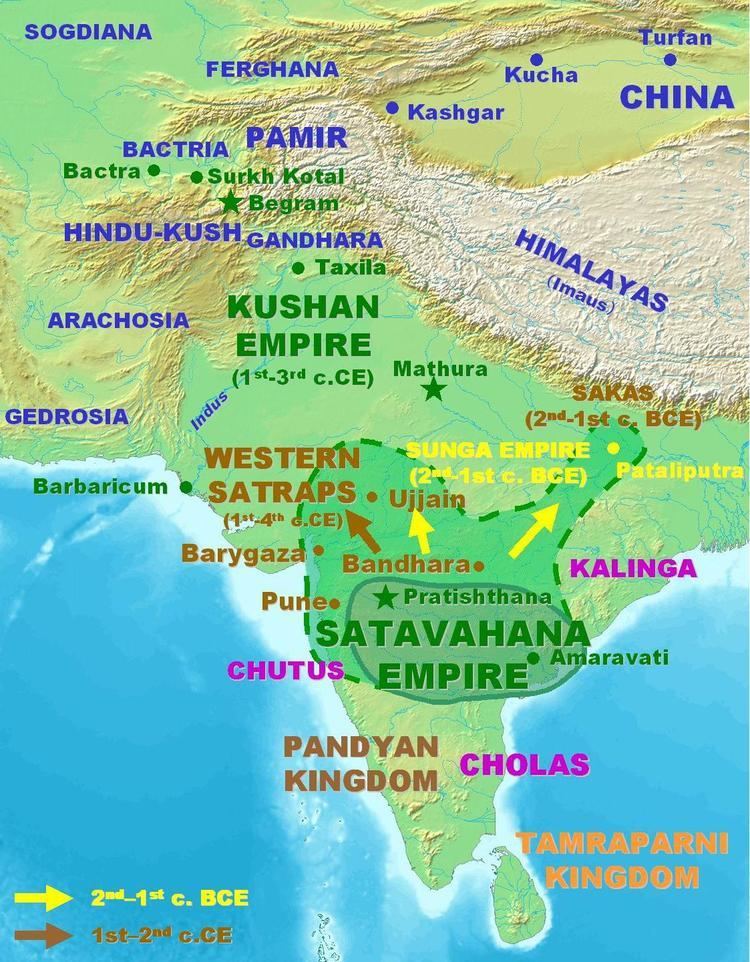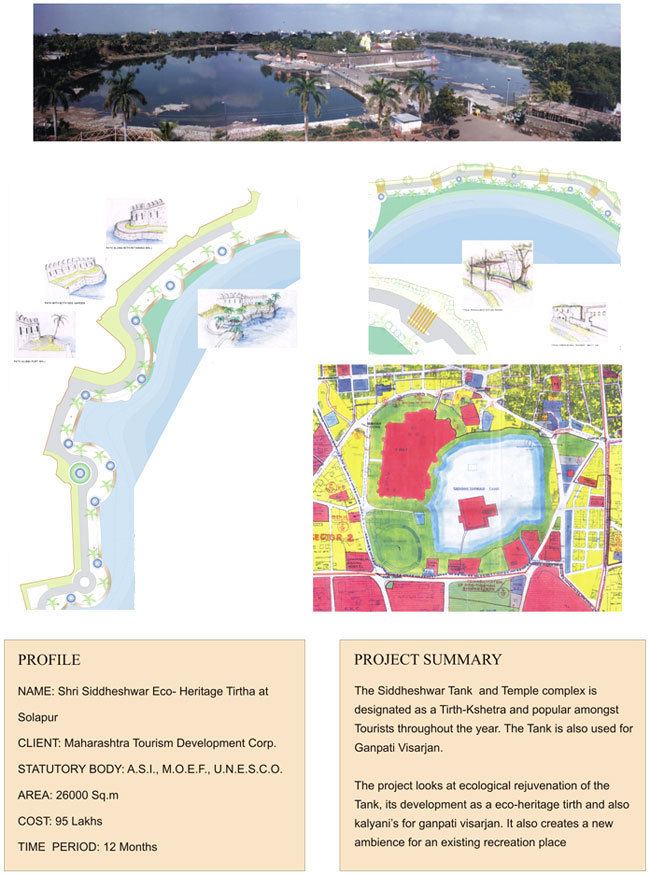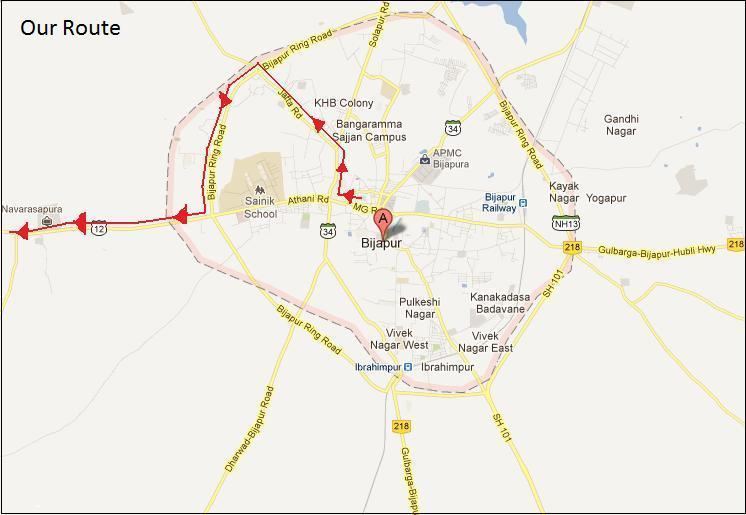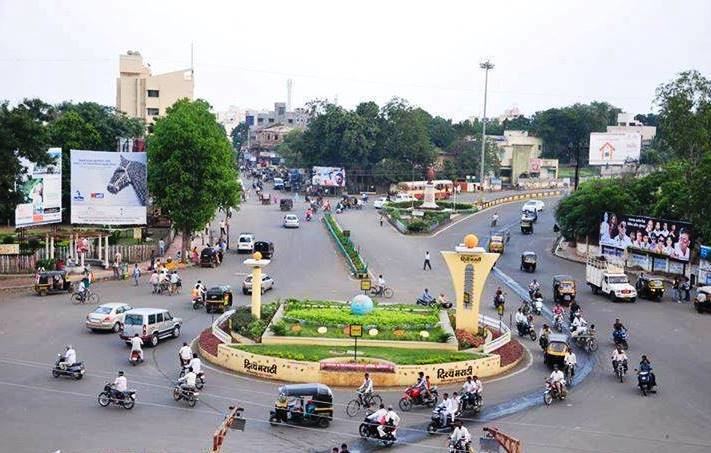Country Region Mayor Prof Sushilatai Abute | ||
 | ||
Colleges and Universities University of Solapur, Dr. V. M. Government Medical College | ||
Languages spoken Official, Marathi | ||
Map of Solapur
Solapur ([Sōlāpūr]) ( pronunciation ) is a city located in the south-western region of the Indian state of Maharashtra. Solapur is located on major road and rail routes between Mumbai and Hyderabad, with a branch line to the cities of Bijapur and Gadag in the neighbouring state of Karnataka. It is classified as a 2 Tier and B-2 class city by House Rent Allowance (HRA) classification by the Government of India. It is the 49th most populous city in India and the 43rd largest urban agglomeration.
Contents
- Map of Solapur
- Siddheshwar temple solapur maharashtra
- Sand art igt2 solapur
- Etymology and history
- Toponomy
- Culture
- Demographics
- Geography and climate
- Civic administration
- Solapur University
- Colleges
- Medical
- Engineering
- Architecture
- Schools
- Science museum
- Research centres
- Tourism
- Sports
- Economy
- MIDC
- Beedi industry
- Environment
- Rail
- Some trains originatingterminating in Solapur
- Road
- Air
- Utility services
- Notable people
- References

Solapur district has the highest number of sugar factories (total 33) in India. Solapur leads Maharashtra in production of Indian cigarettes or beedi. Solapuri Chadars and towels are famous in India and also at a global level, however there has been a significant decline in their exports due to quality reasons. Solapuri chadars are the famous and first product in Maharashtra to get a Geographical Indication tag It has been a leading centre for cotton mills and power looms in Maharashtra. Solapur had the world's second-largest and Asia's largest spinning mill. The National Research Centre on Pomegranate (NRCP) of India is located in Solapur. and pomegranate farming is done on a large scale in Solapur District. The Science Centre in Kegaon (Solapur) is the third largest and prominent scientific association in Maharashtra. The Raichur-Solapur Power Transmission line of 765 kV power capacity suffices the power grid accessing need of the southern states of Karanataka and Andhra Pradesh. The first waste-to-energy electricity plant in Maharashtra is situated in Solapur.

The Gramadevata (Chief deity) of the city is Shri Shivyogi Siddheshwar. The "Nandidhwaj" procession on the Hindu festival of Makar Sankranti and on account of it an annual fair locally known as Gadda Yatra attracts large crowds and is associated with the marriage of Lord Siddheshwar. In 1992, the Solapur Municipal Corporation extended its area up to 300 square kilometres (120 sq mi) by merging its suburbs.

Siddheshwar temple solapur maharashtra
Sand art igt2 solapur
Etymology and history

The Solapur District was ruled by various dynasties such as Andhrabhratyas, Chalukyas, Rashtrakutas, Yadavas and Bahamanis. 'Solapur' spelled in (Marathi: सोलापूर Kannada:ಸೋಲಾಪುರ) is believed to be derived from the combination of two Sanskrit words: 'Sola (Sanskrit: सोला/सोळा)' meaning "sixteen" and 'pur (Sanskrit: पूर)' meaning "village". The present city of Solapur was considered to be spread over sixteen villages viz. Aadilpur, Ahmedpur, Chapaldev, Fatehpur, Jamdarwadi, Kalajapur, Khadarpur, Khandervkiwadi, Muhammadpur, Ranapur, Sandalpur, Shaikpur, Solapur, Sonallagi, Sonapur and Vaidakwadi and all these villages are now merged with Solapur Municipal Corporation. It is evident from the inscriptions of Shivayogi Lord Siddheshwar of the time of the Kalachuristis of Kalyani, that the town was called 'Sonnalage' which came to be pronounced as 'Sonnalagi'. The town was known as Sonnalagi even up to the times of Yadavas. A Sanskrit inscription dated (Sanskrit:शके १२३८) Śakē 1238, after the downfall of the Yadavas found at Kamati in Mohol shows that the town was known as Sonalipur. One of the inscriptions found in Solapur fort shows that the town was called Sonalpur while another inscription on the well in the fort shows that it was known as Sandalpur. Subsequently, the British rulers pronounced Solapur as Sholapur and hence the name of the district. The present Solapur district was previously part of Ahmednagar, Pune and Satara districts. In 1838 it became the Sub-district of Ahmednagar. It included Barshi, Mohol, Madha, Karmala, Indi, Hippargi and Muddebihal Sub-divisions. In 1864 this Sub-district was abolished. In 1871 this district was reformed joining the Sub-divisions viz. Solapur, Barshi, Mohol, Madha and Karmala and two Subdivisions of Satara district viz. Pandharpur, Sangola and in 1875 Malshiras Sub-division was also attached. After the State reorganisation in 1956 Solapur was included in Bombay State and it became a full-fledged district of Maharashtra State in 1960.
A prominent Kannada woman and writer Jayadevi Taayi Ligade and some of Lingayat and other Kannadigas had tried for inclusion of Solapur region into Karnataka state (former Mysore state) on grounds of linguistic majority of Kannada speaking people in and around Solapur region. and the demand was again asserted by Chief Minister of Karnataka B. S. Yeddyurappa in 2010.
The Solapur Municipal Council was the first municipal council to hoist the indian national flag on the Municipal Council building in 1930. The municipal corporation building was built by Rao Saheb Mallappa Warad. He was also one of the first to bring the farming tractor to India. It was his wish that the building should be used for some public purpose and thus the building was made the municipal council. The building is also called Indra Bhawan which means 'Abode of Indra' (Lord Indra). Mallappa Warad was also one of the ten members of 'Chamber of Merchants' under Queen Victoria.
Taking the spirit of Dandi March from Mahatma Gandhi, the freedom fighters of solapur hoisted the National Flag on 6 April 1930 on the Municipal Council building. This was the first and the unique incidence of such kind throughout the country.
During the Indian independence movement, the people of Solapur enjoyed full freedom on 9–11 May 1930. However, this resulted in the executions of Mallappa Dhanshetti, Abdul Rasool Qurban Hussein, Jagannath Bhagwan Shinde and Shrikisan Laxminarayan Sarada, who were hanged on 12 January 1931, in the prison at Pune. This resulted in the city becoming recognised as "The City of Hutatmas" literally "The City of Martyrs".
There is also one of the oldest Ganesh temples, Ajoba Ganpati temple, which started celebrating the Ganesh festival in 1885.
Toponomy
The inscriptions of chief deity of Solapur Shivyogi Shri. Siddheshwar of the time of the Kalachuri (Basavakalyan) suggest that the town was called "Sonnalage" which came to be pronounced as "Sonnalagi". A Sanskrit inscription dated Shake 1238, after the downfall of the Yadavas found at Kamati in Mohol shows that the town was known as Sonalipur. One of the inscriptions found in Solapur fort shows that the town was called Sonalpur. It was the main commercial hub of the Devagiri Yadavas and an important trading city. The town was known as Sonnalagi even up to the times of the Yadavas of Devagiri.
Culture
Solapur is a city with multi-linguistic and multi-cultural features. Solapur has a mixture of Marathi and Kannada speakers. The festival of Makar Sankranti is one of the largest festivals celebrated by the Kannada speaking people(Lingaayata) in Solapur. The Nandidhwaj rally and their marriage is the important part of the festival. The Nandidhwaj rally goes through the 68 temples of Lord shiv which are situated in different parts of the city. Gadda yatra is another important part of this festival. It is a fair which is organised on Hom Maidan. Along with Makar Sankranti people also celebrate Shiv Jayanti, Gudipadwa, Diwali, Ganesh Chaturthi and some more. People also celebrate National festivals. Navratri is another big festival in Solapur. It is celebrated at Rupabhawani temple located at Tuljapur road. People visit the temple to worship Goddess Rupabhawani for nine days in Navratri.
Demographics
As per 2011 census of Solapur city and as per provisional reports of the Census of India, the population of Solapur in 2011 was 951,118, of whom av were male and 468,924 were female.
Solapur's population, with the inclusion of its suburbs, increased to 1,250,000 reorganised in 2012.
In 2011, the otal literates in Solapur city are 710,180 of whom 390,335 are males while 319,845 are females. The average literacy rate of Solapur city is 83.88 percent of which male and female literacy was 91.31 and 76.30 percent respectively.
Hinduism is the majority religion in Solapur city with 75.73% followers. Islam is the second most popular religion, with approximately 20.64% following it. Christianity is followed by 0.73%, Jainism by 1.00%, Sikhism by 0.06% and Buddhism by 0.06%. Around 0.03% stated 'other religion', and approximately 0.19% stated 'no particular religion'.
Geography and climate
Solapur is located at 17.68°N 75.92°E / 17.68; 75.92. It has an average elevation of 458 metres (1502 feet). It is bordered by Ahmednagar district on the north; Osmanabad district on the north and northeast.
Gulbarga district on the southeast and Bijapur Districts on the south of Karnataka State, Sangli district on the south and southwest; Satara district on the west, and Pune district on the northwest. It is situated at a distance of 410 km (250 mi) from the Maharashtra State Capital of Mumbai by road and train.
Solapur is at a distance of 245 km (152 mi) from Pune and 305 km (190 mi) from Hyderabad. Solapur is situated on the Deccan plateau.
Solapur falls under the category of dry (arid and semiarid) climate according to the Köppen climate classification. The city experiences three distinct seasons: summer, monsoon and winter. Typical summer months are from March to May, with maximum temperatures ranging from 30 to 40 °C (86 to 104 °F). The warmest months in Solapur are April and May. The typical maximum temperatures being 40 °C (104 °F) or more. The highest temperature ever recorded is 46.0 °C (114.8 °F) in May 1988. Although summer does not end until May or even the midst of June, the city often receives locally developed heavy thundershowers in May (although humidity remains high). The monsoon lasts from June to the end of September, with moderate rainfall. The city of Solapur receives an average rainfall of 545 mm (21.5 in) per year. Winter begins in November and lasts until the end of February, with the temperatures occasionally dropping below 10 °C (50 °F). Solapur lies very close to the seismically active zone around Killari, Latur District, about 100 km (62 mi) east of the city.
Civic administration
The civic administration of the city is managed by the Solapur Municipal Corporation, which was established on the Maharashtra Day of 1 May 1964 in the building constructed by Mallappa Warad in 1930. The corporation oversees the engineering works, health, sanitation, water supply, administration and taxation in the city. It is headed by a mayor who is assisted by municipal commissioner and elected representatives. The city is divided into 135 wards and 6 zones. The corporation members also known as corporators are elected by the citizens of Solapur every five years. The corporators in turn elect the mayor. Its activities include developing new layouts and roads, town-planning and land-acquisition.
Solapur University
The colleges and the institutes in centre of Shivaji University (Kolhapur) at Solapur were functioning with the departments of Polymer Chemistry, Applied Physics/Electronics and Geology, with the masters courses and M. Phil, PhD research in these areas. The centre was located on the old campus of Dr. V. M. Government Medical College that was later relocated to Police Golibar Maidan. The centre was transformed to the regular university to serve the students of Solapur district and was formally inaugurated on 3 August 2004.
Colleges
Solapur is home to engineering institutes, medical colleges and pharmacy colleges. It also has another 40 colleges in the city.
Medical
Engineering
Architecture
Schools
Solapur has many good schools.
Science museum
Solapur Science Centre is a science museum and is the third in the state after Nehru Science Centre, Worli in Mumbai and Raman Science Centre in Nagpur. The Science Centre is located at Kegaon, Hiraj Road, near Solapur University beside the Pune-Solapur National Highway. The Centre works with the motto of propagating science to the masses. Night sky observation through telescopes is one of the many programmes of the Centre.
Research centres
Tourism
Pandharpur is a holy and famous pilgrimage place dedicated to Lord Vitthal and Shri. Rakhumai goddess prominently worshipped among Varkari community. It is also one of the Kuldaivat of Maharashtra State.In year four big Wari festivals of lord Vithal at Pandharpur. It is located 72 km by road from Solapur District headquarters.
An important tourist destination is Siddeshwar Temple, the abode of Siddheshwar (Siddhrameshwara) built in the 16th century. It attracts 3.5million pilgrims yearly. Solapur is also famous for its Markandeya Temple built in 1893, the Venkateshwara Temple built in 1970, and the Rupa Bhavani temple built in the 19th century, Shri Shankar Temple. The Baba Umer Dargah of Solapur is a shrine revered by Muslims. Solapur has a land based fort in the city centre.
Akkalkot was the home to Shri Swami Samarth Maharaj, a 19th-century saint who is believed by his devotees to be an incarnation of Lord Dattatreya. Akkalkot State during the British Raj, was a princely state ruled by the royal Bhonsale dynasty.
Sports
Indira Gandhi Stadium, Solapur in Solapur, formerly known as Park Stadium, hosts Ranji Trophy matches and is the home venue for Maharashtra cricket team.
Economy
Solapur is located at an important junction of the North-south railway line which provides good transportation infrastructure for trade and industry. There are a number of medium and small scale and medium industries found in the district, and it is one of the prime centres of the handloom and powerloom industry, cotton mills and the beedi industry. Rapier Terry Towels is now also an emerging industry in Solapur. Solapur is well known for the bed sheets produced here, and has a reputation for the same. Textiles are an important aspect of the economy. As the epic growing part in industrial sector, Sanghvi Towels are known as the parents of Rapier industries. They introduced the city how to go with the flow of changing demands of the Terry Towels market, following it many business houses have changed to Rapier Industries and now Rapier Chaddar Looms have been also introduced to the weaving sector by Bomdyal Textiles. The city is home to Precision Camshafts Limited one of the largest manufacturers in camshafts in the world. In the agricultural field, the district has a well established market in oilseeds. The major crops grown in the district include jowar, wheat and sugarcane.
MIDC
MIDC areas are spread all over in Solapur district:
Beedi industry
The beedi industry is the second important industry in Solapur district. Beedi is basically a kind of local cigarette, where tobacco is wrapped in a tendu leaf and tied at the end with a coloured thread. The work of beedi rolling falls under the category of cottage industry. Typically women are employed in these industries and they work from home. The largest beedi-producing industry in the state of Maharashtra is in the district of Solapur. There are 115 units of 29 various beedi factories.
Environment
Solapur is one of the most-polluted cities in Maharashtra due to the effluent chemicals produced as the waste products from the textile industries in its region. As many vehicles in the city utilise diesel fuel, it also generates tremendous smog emitted by sugar factories and heavy textiles industries in the city's suburb. Various efforts are being made by Maharashtra Pollution Control Board (MPCB) to reduce air pollution and its environmental effects. The city has launched a GO-GREEN scheme by planting trees in the city and developing greenery with the help of various eco-friendly people in the city.
Rail
Solapur railway station is the main railway hub within the city. The Solapur Railway Division is an important division connecting South India to Western & North west India. Trains from Ahmedabad, Jaipur, New Delhi, Mumbai, Pune etc., ply to Southern states (Telangana, Karnataka, Tamil Nadu & Kerala) via Solapur.
Some trains originating/terminating in Solapur
Hotgi Junction and Kurduvadi Junction are two junction railway stations present in the Solapur district.
Road
Solapur internal city transport is managed by SMT (Solapur Municipal Transport), SMC and other private cabs.
Solapur is well connected by road with major cities of Maharashtra as well as the adjoining State Capital of Hyderabad and important cities in Karnataka by four National Highways – NH 9 highway connecting Pune with Vijaywada via Hyderabad, NH-13 connecting Solapur to Mangalore, Karnataka and NH-211 connecting Solapur to Dhule. Ratnagiri-Nagpur National highway NH-204 passes through city, connecting Solapur to other important cities in Maharashtra like Nagpur, Sangli, Kolhapur and Nanded. Recently sanctioned National Highways- (Solapur - Kalaburagi) and Ratnagiri-Solapur-Yavatmal-Nanded-Nagpur. (Solapur-Bijapur) Road section in NH-13 is proposed to be improved by its four laning. The Solapur-Aurangabad national highway is also proposed for its four laning to reduce the time and cost in travelling from Solapur to Aurangabad.
Air
Solapur Airport (IATA code: SSE) is located to the south of Solapur city. There are no scheduled flights operating out of Solapur Airport. The Government of Maharashtra has planned to upgrade the airport.
Utility services
The electrical supply to the city is managed by the Maharashtra State Electricity Distribution Company Limited and water is supplied from the Ujjani Dam on the Bhima River.
